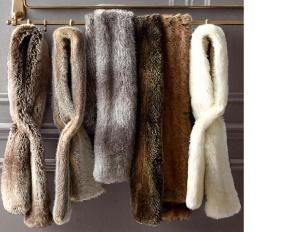Everyone can agree: There is something about fur. And thanks to advances in technology, it’s becoming harder and harder to tell the more-expensive real stuff from the faux fur. But as one can imagine, that has not always been the case. It was not that long ago that fur had its own class or caste system – it was easy to tell who were the fashionable well-to-do types with the real fur blankets on their beds, and who were the middle-class families who wanted to look the part with their faux fur blankets. Now, though, the differences are more subtle and the “classes” of fur buyers have begun to blur.

Faux fur blankets, coats and scarves have been in the market about 80 years, which is about 80,000 years behind fur in the marketplace. And while the prices are distinctly different, in some ways faux fur has made up a steep curve to catch up in quality to the real thing. But what is the real history behind faux fur and how has it evolved to be a quality alternative to real animal fur? Glad you asked.
Faux Fur: A Brief History
Real fur being used as clothing had been a staple in fashion for thousands of years. But when people evolved and stopped killing animals for their clothing and started mass-producing fur garments, the market for fur was rather elite even as there was a market for the real thing – especially in fashion-forward cities like Paris and New York, and in places where it Just. Got. Cold.
But since many other people got cold, not just the well-heeled, manufacturing had advanced to the point that in 1929, the first faux fur – developed from alpaca fur – was developed. The new fabric didn’t reach a certain level of popularity until the 1950s when polymer manufacturing developed to replace alpaca and it started resembling fur without the animal. Acrylic was among the first materials in faux fur to replace alpaca, and those polymers had continued to develop and evolve to create more fur-like qualities. This came about through experimentation with combining polymers to create what would be called modacrylics, which have resulted in faux fur that has now taken on a texture and feel that is very similar to real fur and sold at a fraction of the price.
Why Did Faux Fur Have to Evolve, Anyway?
While faux fur wasn’t technically fake at first since it was directly made from alpaca fur, the goal ultimately wasn’t to make it surly fake; the goal was to make the alpaca work better as an alternative to mink, fox and the rest of the fine furs. And like most real furs, alpaca was pretty inflexible; it was hard to make into something that it wasn’t. Alpaca fur was not of a fine texture, there were limitations on colors and it was not as easy to work with as a fabric. While it was cheap, it showed itself to be cheap.
And if there was a choice between a real fur at the premium price and a cheaper and cheaper-looking alpaca fur garment, people would generally save their money and pay more for the “real” thing. The acrylics and polymers were becoming more vital in manufacturing around this time, so some experimentation came about to try to find a way to make faux fur cheap but not feel cheap- in other words, how to make a mink or fox shawl that wasn’t actually from a mink or fox? As texture was very important with customers of fur, it was necessary for the faux-fur market – if there was ever going to be one – to at least come closer to the feel and texture of real fur without the real-fur price. That is where acrylics and now modern modacrylics and other polymers came in.
Faux Fur: Pros and Cons
The beauty of the polymers in faux fur is that they can be made to simulate real fur, and you can make faux fur blankets and garments in a variety of colors – especially those that don’t occur naturally among minks or foxes. This can mean vibrant colors and color combinations that are truly unique. Like how about leopard or tiger prints, or something purple or brick red?
Some other key positives are – of course – animals are not harmed in the making of modern faux fur (yay for the alpaca!); it is a fabric so it is easy to sew with; and with proper care it can last a long time. On the down side, because faux fur is not natural fabric, it does not biodegrade well, and it can be difficult to clean in order to maintain its feel and texture. You can’t dry clean it, but you certainly can’t put it through a washing machine cycle unless you don’t mind it looking matted and losing is sheen.
However, as long as you are careful about getting faux fur dirty in the first place and you take care to clean it (usually a spot clean works best, or very light wet cleaning with a low-heat blow dryer and a brush), there is no question that faux fur has become a relatively inexpensive fashion alternative to real fur – and you won’t annoy the animal-rights activists in your neighborhood.


